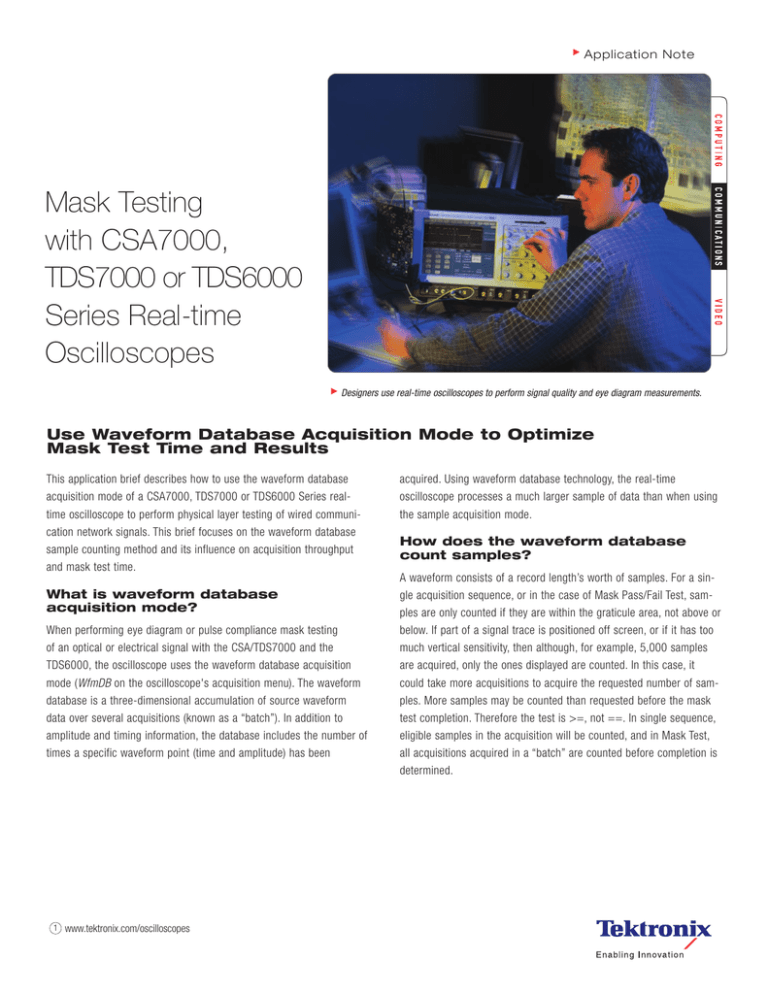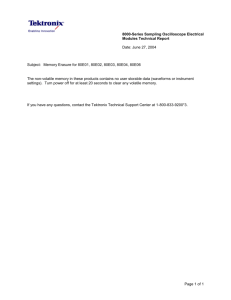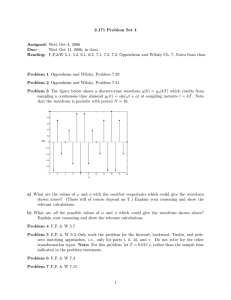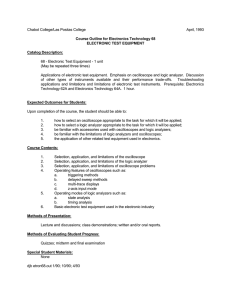
Application Note
Mask Testing
with CSA7000,
TDS7000 or TDS6000
Series Real-time
Oscilloscopes
Designers use real-time oscilloscopes to perform signal quality and eye diagram measurements.
Use Waveform Database Acquisition Mode to Optimize
Mask Test Time and Results
This application brief describes how to use the waveform database
acquisition mode of a CSA7000, TDS7000 or TDS6000 Series realtime oscilloscope to perform physical layer testing of wired communication network signals. This brief focuses on the waveform database
sample counting method and its influence on acquisition throughput
and mask test time.
What is waveform database
acquisition mode?
When performing eye diagram or pulse compliance mask testing
of an optical or electrical signal with the CSA/TDS7000 and the
TDS6000, the oscilloscope uses the waveform database acquisition
mode (WfmDB on the oscilloscope's acquisition menu). The waveform
database is a three-dimensional accumulation of source waveform
data over several acquisitions (known as a “batch”). In addition to
amplitude and timing information, the database includes the number of
times a specific waveform point (time and amplitude) has been
1
www.tektronix.com/oscilloscopes
acquired. Using waveform database technology, the real-time
oscilloscope processes a much larger sample of data than when using
the sample acquisition mode.
How does the waveform database
count samples?
A waveform consists of a record length’s worth of samples. For a single acquisition sequence, or in the case of Mask Pass/Fail Test, samples are only counted if they are within the graticule area, not above or
below. If part of a signal trace is positioned off screen, or if it has too
much vertical sensitivity, then although, for example, 5,000 samples
are acquired, only the ones displayed are counted. In this case, it
could take more acquisitions to acquire the requested number of samples. More samples may be counted than requested before the mask
test completion. Therefore the test is >=, not ==. In single sequence,
eligible samples in the acquisition will be counted, and in Mask Test,
all acquisitions acquired in a “batch” are counted before completion is
determined.
Mask Testing with Real-time Oscilloscopes
Application Note
Clock
record points
Data
1
1st acquisition cycle
2
3
4
5
6
7
8
Eye Diagram
2nd acquisition cycle
3rd acquisition cycle
nth acquisition cycle
Figure 1: In equivalent-time sampling mode, a real-time oscilloscope makes
multiple acquisitions of a repetitive waveform to obtain the sample density
required for a waveform record.
In real-time or continuous acquisition mode, if the entire trace is
displayed, one triggered acquisition should be sufficient to acquire
5,000 samples for an equal record length of 5,000. If 5,001 samples
are requested, you will get 10,000 samples and it will take two
acquisitions. If fewer samples are requested than the record length,
the number of samples would be the same as the record length. Like
the fast frame, average, or envelope acquisition modes, waveform
database acquisition mode minimizes the “down time” between acquisitions by acquiring a “batch” of acquisitions and then processing
them. This also reduces the overhead time of displaying and processing other features such as measurements and histograms.
If you have a repetitive signal, you can use the equivalent-time
sampling mode of your real-time oscilloscope to speed up acquisition
throughput. In equivalent-time sampling mode, fewer samples are
acquired per acquisition for a given record length, but potentially
more acquisitions are acquired in a batch.
2
www.tektronix.com/oscilloscopes
1
2
3
4
5
6
7
8
Figure A: Data is collected for display as an eye diagram.
Compliance verification with an eye
diagram
The “eye diagram” – the display that results from the overlap of a
series of data waveforms – is the most common method of characterizing the quality of a signal. It is obtained when the oscilloscope is
triggered synchronously to the data stream, while the input channel is
connected to the data stream carrying random or pseudorandom bits.
A synchronous clock signal, the data itself or the clock recovered from
the data (if the oscilloscope has a clock recovery circuit) is used to
trigger the oscilloscope. In one captured screen, all possible signal
transitions of the signal are displayed, hence the eye opening, noise,
jitter, rise and fall times and amplitude can be observed and measured
from a single picture.
Measure transmission quality
An eye diagram is a very convenient oscilloscope display that presents
the most important time-domain signal characteristics all at once,
saving time and showing the interaction of rise and fall time, overshoot, undershoot, ringing, jitter and noise. This display can be used
for qualitative analysis while adjusting the persistence, whereas the
embedded statistical database of the oscilloscope can be used to
make quantitative measurements from the eye diagram.
Mask Testing with Real-time Oscilloscopes
Application Note
What is equivalent-time sampling?
Figure B: A larger opening indicates a greater tolerance for noise and jitter
as well as better receiver sensitivity. A wide top, base and transition region
indicate reduced receiver sensitivity.
A real-time oscilloscope uses equivalent-time sampling to extend its
sample rate beyond its real-time maximum sampling rate. It takes
a few samples with each trigger event and eventually (over many
repetitions of the event) obtains enough samples to construct a
waveform record. This method is called random equivalent time
sampling because it takes samples continuously, independent of the
trigger position, and displays them based on the time difference
between the sample and the trigger. Although the samples are taken
sequentially and regularly in time, they are randomly placed with
respect to the trigger. Therefore, equivalent-time sampling should
only be used on repetitive signals.
Equivalent-time sampling is different than the sequential sampling
method of sampling oscilloscopes such as the TDS/CSA8000. Because
sequential sampling is not random, sampling oscilloscopes depend
on repetitive signals and multiple trigger events and acquisitions to
build a waveform.
Figure C: An example of an electrical pulse mask.
Prevent degradation of receiver sensitivity
Rather than extracting numeric information on the signal characteristics, the two-dimensional shape can easily be compared to a group of
violation zones called a mask. (Examples of eye diagrams can be found
throughout this document). Masks are defined by and for each standard. Comparing the shape of an eye or a pulse to a mask, is a very
fast and efficient method of ensuring that the transmitter source signal
will not cause excessive degradation of the receiver performance.
www.tektronix.com/oscilloscopes 3
Mask Testing with Real-time Oscilloscopes
Application Note
How does a TDS/CSA7000 real-time
oscilloscope compare to a TDS/CSA8000
Series sampling oscilloscope?
What a real-time oscilloscope such as the TDS/CSA7000 considers
a waveform (a waveform being a record length worth of samples),
a sampling oscilloscope considers an acquisition. The sampling
oscilloscope acquires samples one at a time in sequential triggers.
This method is comparable to a real-time oscilloscope acquiring
groups of samples in multiple, random triggers in equivalent-time
sampling mode, or in batches from sequential triggers when in
waveform database mode.
For example, selecting the number of acquisitions or mask samples on
the CSA8000’s Setup Menu (Figure 2) under Condition, is the same
type of operation as providing the number of waveforms on the
TDS7000’s Mask Pass/Fail Test Menu under Number of Wfms (when
not acquiring in waveform database mode). In waveform database
mode, the TDS7000’s Samples are equivalent to the TDS8000’s
Mask Samples Conditions.
How does waveform database
acquisition mode affect throughput?
Figure 2: CSA/TDS8000 Acquisition Mode setup menu.
4
www.tektronix.com/oscilloscopes
As mentioned earlier, a waveform is a record length’s worth of samples. (Samples divided by record length roughly indicates the number
of waveforms in a batch of acquisitions.) The greater the number of
samples acquired, the faster the acquisition throughput. To increase
acquisition throughput, simply increase the number of samples
(Figure 6 shows the User Interface Field where the number of samples
can be updated). Keep in mind that acquisition throughput speed is
ultimately controlled by the amount of acquisition memory on your
oscilloscope—at a certain point, increasing samples will stop affecting
throughput.
Mask Testing with Real-time Oscilloscopes
Application Note
Setting up a mask in waveform
database mode
Setting up the test
1. Before selecting a mask, verify that the signal is coming through as expected.
An easy way to do that is by using the autoset function on the oscilloscope.
Autoset works off of the edge trigger but lets you see that there is an actual
connection to the signal source.
2. Select the mask, and reset the oscilloscope, using the mask autoset function.
3. The mask should still be centered and shown similarly to when first selected.
If the signal exceeds the dynamic range of the O/E, the signal is overdriven
and the mask will be now larger, and possibly partially off-screen as shown
in Figure 4.
4. If your signal is overdriven, adjust it after turning off persistence and
selecting a minimum number of samples. This is the best configuration
for manipulation. This gives you the most responsive display and lets you view
your current changes in isolation. See Figure 3.
Figure 3: A signal that is not overdriven.
Figure 4: An overdriven signal.
www.tektronix.com/oscilloscopes 5
Mask Testing with Real-time Oscilloscopes
Application Note
Figure 5: Setting up Wfm Ct in the Histogram measurement menu.
Figure 6: Setting up the pass/fail test parameters.
5. Sometimes with a very clean signal, and after a very short period of time, with
infinite persistence on, it may appear as if nothing is happening, even though
the trigger light is on. This is because the samples are all being
overlaid on each other and the color algorithms normalize those additions.
To check that updates are occurring, turn off infinite persistence momentarily.
Or, set up the “Wfm Ct ” histogram measurement (Figure 5) and the number
should increase. (See sidebar for details on Infinite persistence in waveform
database mode.)
The pass/fail parameter is the failure threshold (the number of
samples that must fail in order to fail the test). The test will declare
a failure if the number of samples is more than or equal to the
failure threshold.
6. After you have set up the signal and mask, you can turn infinite persistence
back on and increase samples as desired.
1. Have the instrument beep (BEEP)
Running mask pass/fail tests
3. Send a trigger pulse out on the AUX OUT connector (AUX Out)
You can set up an automatic pass/fail mask test to determine whether
a device exceeds the mask boundaries within a user-defined number
of samples. To run a series of mask tests on a signal, set up:
4. Stop signal acquisition immediately (Stop Acq)
1. The delay time. (The time from when the mask test starts to when the
instrument begins sampling.)
2. The number of samples to test (when in waveform database mode).
6
www.tektronix.com/oscilloscopes
You can also define what you want the oscilloscope to do when a mask
test fails and what you want it to do when the mask test is completed.
More than one action can occur concurrently. Some examples are:
2. Send an SRQ out on the GPIB bus (SRQ)
5. Print the instrument screen image to a printer (Print)
6. Save the waveform data of the first waveform that causes the test to fail
to a .wfm file (Wfm)
7. Save time, date, and basic test information of the first waveform that causes
the test to fail to an ASCII text (.txt) file (Log Date)
Mask Testing with Real-time Oscilloscopes
Application Note
Figure 7: The test failed because the number of mask hits is higher than
the failure threshold.
If higher throughput is your goal (for example, acquiring a statistical
sample of data for measurement or collecting the most data in the
shortest amount of time), increase the number of samples.
If throughput is less important than the most accurate failure threshold
value, set up your test with fewer samples and use Pass/Fail Test
Repeat ON. This will allow the test to continue running with smaller
batches until the specified end-of-test condition is met.
Figure 8: The test passed.
Using infinite persistence in waveform
database mode
In waveform database acquisition mode, infinite persistence is not
handled by the display, but by the acquisition, so that the waveform
accumulates all the samples acquired since the last reset. Variable
and no persistence function the same way in waveform database
acquisition mode. In both modes, samples will be accumulated to
reach the number of samples requested by the user. You can turn on
variable persistence and see signal changes degrade, but they are
not reflected in the actual underlying, stored waveform as opposed
to the way they are reflected in the waveform in infinite persistence.
(In single sequence mode, infinite persistence refreshes at the first
acquisition and accumulates acquisition data through multiple
acquisition batches to the number of samples specified by the user.)
Measurements on a channel can cause acquisitions even when the
channel is off. Acquisitions are not displayed while acquiring.
However, if infinite persistence is on, you can turn on Channel 1
when stopped for a full display trace accounting. Infinite persistence
can slow the display and measurement update rate when the samples are small, but do not have much effect if samples are long.
www.tektronix.com/oscilloscopes 7
Mask Testing with Real-time Oscilloscopes
Application Note
Contact Tektronix:
ASEAN Countries & Pakistan (65) 6356 3900
Australia & New Zealand (65) 6356 3900
Austria +43 2236 8092 262
Belgium +32 (2) 715 89 70
Brazil & South America 55 (11) 3741-8360
Canada 1 (800) 661-5625
CSA7000 Series
Versatile, high-performance, real-time communications signal analyzers dedicated
to rapid design analysis and verification of communications signals up to 2.5 Gb/s
rates (OC-48/STM-16 or Fibre Channel FC2125).
Central Europe & Greece +43 2236 8092 301
Denmark +45 44 850 700
Finland +358 (9) 4783 400
France & North Africa +33 (0) 1 69 86 80 34
Germany +49 (221) 94 77 400
Hong Kong (852) 2585-6688
India (91) 80-2275577
Italy +39 (02) 25086 1
Japan 81 (3) 3448-3111
Mexico, Central America & Caribbean 52 (55) 56666-333
The Netherlands +31 (0) 23 569 5555
Norway +47 22 07 07 00
TDS7000 Series
Digital Phosphor Oscilloscopes
TDS7000 Series oscilloscopes, with bandwidth from 500 MHz to 4 GHz and up to
20 GS/s real-time sample rate, are high-performance real-time oscilloscopes for
verification, debug and characterization of sophisticated electronic designs.
People’s Republic of China 86 (10) 6235 1230
Poland +48 (0) 22 521 53 40
Republic of Korea 82 (2) 528-5299
Russia, CIS & The Baltics +358 (9) 4783 400
South Africa +27 11 254 8360
Spain +34 (91) 372 6055
Sweden +46 8 477 6503/4
Taiwan 886 (2) 2722-9622
United Kingdom & Eire +44 (0) 1344 392400
USA 1 (800) 426-2200
USA (Export Sales) 1 (503) 627-1916
TDS6604 DSO
The world's first 6 GHz oscilloscope delivers the performance you need for your
most demanding signals. The TDS6604 will take you to a higher level of signal
integrity for next-gen digital designs by providing you with the performance you
need to verify the integrity of your signals and a suite of tools that simplify and
accelerate your design process. With 6 GHz bandwidth and 20 GS/s sample rate on
2 channels, the TDS6604 provides unmatched signal integrity measurements.
For other areas contact Tektronix, Inc. at: 1 (503) 627-7111
Updated 18 April 2002
Our most up-to-date product information is available at:
www.tektronix.com
Copyright © 2002, Tektronix, Inc. All rights reserved. Tektronix products are covered
by U.S. and foreign patents, issued and pending. Information in this publication supersedes that in all previously published material. Specification and price change privileges
reserved. TEKTRONIX and TEK are registered trademarks of Tektronix, Inc. All other
trade names referenced are the service marks, trademarks or registered trademarks of
their respective companies.
06/02 OA/PG
55W-15751-0
8
www.tektronix.com/oscilloscopes



